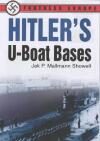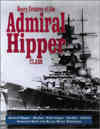Hitler's U-boat Bases
Showell, Jak Mallmann
2002, United States Naval Inst.
ISBN 1557503966
Hardcover
| Type. | General History |
| Pros. | First English-language book on this topic; much valuable information, many photos. |
| Cons. | None to speak of. |
| Rating. |  |
 This is the first major book on this subject to be published in the English language. It follows the format familiar to readers of Showell's work, combining text with numerous black and white photographs (those of wartime vintage largely from the U-boot-Archiv, the post-war photos taken by the author or from private collections). It includes twelve detailed maps illustrating the locations of U-boat bunkers. As usual, Showell has done a thorough job, setting forth the important points clearly, and infusing numerous interesting details into the narrative, so that the dull concrete masses mentally summoned up by the words "bunker" and "base" are dispelled by the lively and complicated reality.
This is the first major book on this subject to be published in the English language. It follows the format familiar to readers of Showell's work, combining text with numerous black and white photographs (those of wartime vintage largely from the U-boot-Archiv, the post-war photos taken by the author or from private collections). It includes twelve detailed maps illustrating the locations of U-boat bunkers. As usual, Showell has done a thorough job, setting forth the important points clearly, and infusing numerous interesting details into the narrative, so that the dull concrete masses mentally summoned up by the words "bunker" and "base" are dispelled by the lively and complicated reality.
The book is divided into three main parts, each further subdivided into short sections: U-Boat Bunkers; Atlantic and Baltic Bases with U-Boat Bunkers; and The Demolishers. The first part, U-Boat Bunkers, is divided into five sub-sections. The Builders provides an overview of the Todt Organisation, the French firms and the foreign labor force involved in the construction of these bunkers. The Building discusses the actual steps involved in construction - pouring of cement, etc. The Buildings describes the four main types of U-boat bunkers; bunkers used for a variety of other purposes (command centers, storage, air raid shelters); and the main components and infrastructure of the bunkers (generators, stores, offices, workshops, etc.). The Support Staff includes a lengthy personal account by a young German who fulfilled an amazing array of duties during service in the dockyard staff. Moving In includes a personal account of taking over command at St. Nazaire by Herbert Sohler and Hermann Schlicht, and a table listing the 7th Flotilla administrative staff and boats attached to it.
The second part, Atlantic and Baltic Bases with U-Boat Bunkers, deals individually with these remarkably varied structures, including history of the port, its geology, weather conditions, how the bunker was built, specific challenges presented by each location, work force and firms involved, damage caused by Allied air raids, postwar fate, and remnants, if any, which may be seen today. Each story, a sub-section each for Norway, Kiel, Hamburg, Bremen, Heligoland, Brest, Lorient, St. Nazaire, La Pallice, and Bordeaux, is unique and compelling. All the stories are fascinating, but perhaps the most interesting of all is that of the Elbe II bunker, which still holds the hulks of three U-boats.
The third part, The Demolishers, describes Allied bombing attacks against the bunkers, their effects, and the countermeasures taken by the Germans. The Tallboy bombs used, also known as earthquake or deep penetration bombs, are described.
In many of his books, Showell takes the opportunity to point out and correct common misconceptions and errors that have been perpetuated over time, and this book is no exception. There is more scope than usual for this in this book, due to its subject matter, and the author focuses on two main topics in particular which he believes deserve more attention. The first is the nature of the Todt Organisation and the work force that built the U-boat bunkers. The author states that, far from being the kind of slave laborers who manned Germany's factories, the laborers who worked on these structures were nearly all volunteers.
The other point Showell emphasizes is one that was not widely discussed until the last decade or so - that is, that strategic bombing was largely useless, damaging its intended targets very little, and accounting for staggering civilian casualties, mainly among the Germans, but also among the French and the foreign workers near the French and other bases.
The book concludes with two appendices, the first detailing the quite complicated administrative structure of the bases, and the second providing the extensive list of rules and regulations governing visits to and use of the 5th U-boat Flotilla at Kiel, from berth allocation for the boats to the rules which must be observed in the various accommodations for officers and men, even to the base cinema schedules.
In summary, this book contains everything you would want to know about U-boat bases, from tips for prospective tourists, to technical specifications of the structures, and everything in between.
Review written by Tonya Allen.
Published on 23 Sep 2002.
This title is highly recommended.
Purchase information: (info) Get Hitler's U-boat Bases now at amazon.co.uk
Get Hitler's U-boat Bases now at amazon.co.uk
Return to our main review page.



